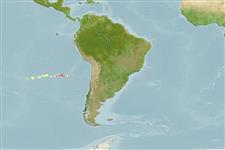Classification / Names
Nombres comunes | Sinónimos | Catalog of Fishes(Género, Especie) | ITIS | CoL | WoRMS | Cloffa
>
Stomiiformes (Lightfishes and dragonfishes) >
Phosichthyidae (Lightfishes)
Etymology: andriashevi: Named in honor of Anatoliy Petrovich Andriyashev, outstanding ichthyologist and taxonomist on his 80th birthday..
Environment: milieu / climate zone / depth range / distribution range
Ecología
marino batidemersal; rango de profundidad 545 - 600 m (Ref. 41740). Deep-water
Southeast Pacific: known only from two seamounts of the Sala y Gomez Ridge and southeastern Pacific.
Tamaño / Peso / Age
Maturity: Lm ? range ? - ? cm
Max length : 20.9 cm SL macho / no sexado; (Ref. 41740)
Short description
Morfología | Morfometría
Espinas dorsales (total): 0; Radios blandos dorsales (total): 11-13; Espinas anales 0; Radios blandos anales: 29 - 31; Vértebra: 45 - 46. Pyloric caeca 7-8; photophores above anal fin 16-17; presence of 9 photophores in both ventroanal series and 20 trunk vertebrae (Ref. 41740).
Life cycle and mating behavior
Madurez | Reproducción | Puesta | Huevos | Fecundidad | Larva
Parin, N.V. and O.D. Borodulina, 1990. Survey of the genus Polymetme (Photichthyidae) with a description of two new species. J. Ichthyol. 30(6):108-121. (Ref. 41740)
IUCN Red List Status (Ref. 130435)
Threat to humans
Harmless
Human uses
Más información
Nombres comunesSinónimosMetabolismoDespredadoresEcotoxicologíaReproducciónMadurezPuestaAgregación para la puestaFecundidadHuevosEgg development
Age/SizeCrecimientoLength-weightLength-lengthLength-frequenciesMorfometríaMorfologíaLarvaDinámica larvariaReclutamientoAbundanciaBRUVS
ReferenciasAcuiculturaPerfil de acuiculturaRazasGenéticaElectrophoresesheritabilidadEnfermedadesProcesamientoNutrientsMass conversion
ColaboradoresImágenesStamps, Coins Misc.SonidosCiguateraVelocidadTipo de nataciónSuperficie branquialOtolitosCerebrosVisión
Herramientas
Special reports
Download XML
Fuentes de Internet
Estimates based on models
Preferred temperature (Ref.
123201): 11.1 - 11.4, mean 11.2 °C (based on 7 cells).
Phylogenetic diversity index (Ref.
82804): PD
50 = 0.5156 [Uniqueness, from 0.5 = low to 2.0 = high].
Bayesian length-weight: a=0.01000 (0.00244 - 0.04107), b=3.04 (2.81 - 3.27), in cm total length, based on all LWR estimates for this body shape (Ref.
93245).
Nivel trófico (Ref.
69278): 3.5 ±0.5 se; based on size and trophs of closest relatives
Resiliencia (Ref.
120179): Medio, población duplicada en un tiempo mínimo de 1.4-4.4 años (Assuming tm=2-4).
Fishing Vulnerability (Ref.
59153): Low vulnerability (16 of 100).
